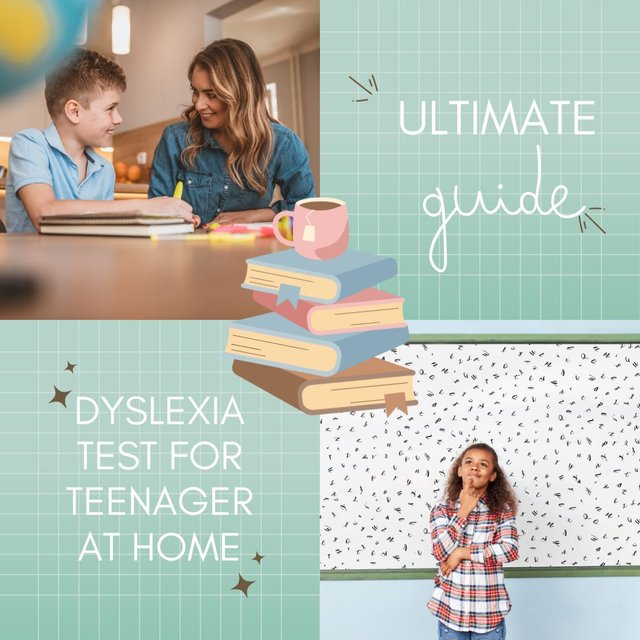
Identifying dyslexia in teenagers can be a crucial step in providing the right support and strategies for their academic and personal development. While professional evaluations are essential for a definitive diagnosis, at-home dyslexia tests can offer valuable insights and serve as a preliminary step towards understanding your teenager's learning difficulties. This ultimate guide will help you navigate the process of conducting a dyslexia test at home, offering practical tips and resources to ensure you get the most accurate and useful results.
Understanding Dyslexia
Dyslexia is a learning disorder characterized by difficulties with accurate and/or fluent word recognition and by poor spelling and decoding abilities. These challenges are often unexpected in relation to other cognitive abilities and the provision of effective classroom instruction. For teenagers, dyslexia can impact not only their academic performance but also their self-esteem and motivation.
Signs of Dyslexia in Teenagers
Before conducting an at-home dyslexia test, it’s important to recognize common signs of dyslexia in teenagers:
• Difficulty reading aloud and pronouncing words correctly
• Poor spelling and frequent writing errors
• Avoidance of reading and writing tasks
• Slow reading speed and comprehension difficulties
• Trouble understanding jokes or idioms
• Difficulty with time management and organization
• Problems following multi-step directions
Recognizing these signs can help you determine whether an at-home dyslexia test might be beneficial for your teenager.
Choosing the Right At-Home Dyslexia Test
Several at-home dyslexia tests are available online, ranging from free screening tools to more comprehensive paid assessments. Here are some reputable options to consider:
Dyslexia Screener by Nessy:
Nessy offers a free online dyslexia screener designed to identify the likelihood of dyslexia in children and teenagers. The test includes questions related to reading, spelling, and phonological awareness.Lexercise Dyslexia Test:
Lexercise provides a free, quick dyslexia screener that assesses a teenager’s reading and spelling skills. It offers a detailed report that can help identify potential dyslexic traits.Dyslexia Quest App:
This interactive app uses games and challenges to assess working memory, phonological awareness, processing speed, and other skills associated with dyslexia. It is available for a small fee on various app stores.The Adult Reading History Questionnaire (ARHQ):
Although initially designed for adults, the ARHQ can be adapted for older teenagers. It assesses reading history and current reading difficulties, providing insights into potential dyslexic traits.
Administering the Test
To ensure accurate results, follow these steps when administering an at-home dyslexia test:
Create a Quiet Environment:
Ensure the testing area is free from distractions and noise. A quiet, comfortable environment will help your teenager focus on the tasks at hand.Explain the Purpose:
Talk to your teenager about why the test is being conducted. Emphasize that the goal is to understand their learning style better and to find ways to support their education.Follow Instructions Carefully:
Read and follow the test instructions meticulously. Some tests may require parental assistance, while others should be completed independently by the teenager.Monitor Without Interfering:
While it’s important to be present during the test, avoid interfering or offering help. Allow your teenager to complete the tasks to the best of their ability.Review the Results Together:
Once the test is complete, review the results with your teenager. Discuss any areas of difficulty and the next steps, which may include seeking a professional evaluation.
Next Steps After the Test
If the at-home dyslexia test indicates a high likelihood of dyslexia, it’s essential to seek a professional diagnosis from an educational psychologist or a specialist in dyslexia. A professional evaluation will provide a comprehensive understanding of your teenager’s learning profile and recommend specific interventions and accommodations.
Supporting Your Teenager
Regardless of the test outcome, there are several strategies you can implement to support your teenager:
• Encourage Reading: Provide access to a variety of reading materials and encourage regular reading habits.
• Use Technology: Assistive technology, such as text-to-speech software and audiobooks, can help mitigate reading difficulties.
• Provide Structured Support: Establish a consistent homework routine and offer organizational tools to help manage assignments.
• Build Confidence: Focus on your teenager’s strengths and celebrate their successes to boost self-esteem and motivation.
Conclusion
Conducting a dyslexia test for your teenager at home can be a valuable step in identifying learning challenges and seeking appropriate support. By recognizing the signs of dyslexia, choosing a reliable at-home test, and taking thoughtful next steps, you can empower your teenager to thrive academically and personally. Remember, early identification and intervention are key to helping individuals with dyslexia achieve their full potential.